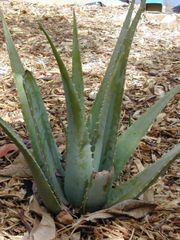Aloe vera
| Aloe vera subsp. var. | ||||||||||||||||||||||||||||||||||||||||||||||||||||||||
|---|---|---|---|---|---|---|---|---|---|---|---|---|---|---|---|---|---|---|---|---|---|---|---|---|---|---|---|---|---|---|---|---|---|---|---|---|---|---|---|---|---|---|---|---|---|---|---|---|---|---|---|---|---|---|---|---|

|
|
| ||||||||||||||||||||||||||||||||||||||||||||||||||||||
| ||||||||||||||||||||||||||||||||||||||||||||||||||||||||
| Standard Cyclopedia of Horticulture |
|---|
|
Aloe humilis, Haw. (A. perfoliata humilis, Linn.). Lvs. suberect, rather incurved, triangular-lanceolate, ¾ x 4 in., gradually acute, somewhat striate, sharply white- tuberculate, at least on the back, and with rather close large white marginal teeth: infl. 1½-2 ft. high: fls. 1½ in. long, red or yellowish, the green-tipped segm. distinct nearly to the base. Cape. Sahn, Aloe §15, f. 1.—With somewhat the habit of Haworthia. Varies from the narrow green-lvd. type into glaucous forms of this, with rather thicker lvs., var. incurva, Haw. (A. incurva, Haw.), B.M. 828, Salm, Aloe §15, f. 3, and rather thin, more concave lvs., var. echinäta, Baker (A. echinata, Willd.), Salm. Aloe §15, f. 2., Berger 64, 65, and one with purplish lvs., var. macilenta, Baker; as well as a broader-lvd. glaucous large form, var. suberecta, Baker (A. suberecta, Haw. A. acuminata major, Salm-Dyck), which is sometimes white-mottled, var. semiguttata, Haw.; a moderately large broad-lvd. form, var. acuminate, Baker (A. acuminata, Haw., A. suberecta. Haw.), B.M. 757; and a small blue- glaucous form with closer prickles and smaller warts, var. subtuberculata, Baker (A. subtuberculata, Haw.). Hybrids are: A. x insignis, Brown (A. humilis x A. drepanophylla), A. x spinosissima, Hort. (A. humilis echinata X A. arborescens pachythyrsa), A. x cyanea, Hort. (A. humilis incurva x A. arborescens frutescens), A. x Todari, Borzi, (A. Todari praecox, Borzi,) A. x Grusonii, Henze, Monatschr. Kakteenk. 11, p. 57. (A. humilis x A. Schimperi), A. x Henzei, Hort. (A. Grusonii x A. variegata), and perhaps A. x laetecoccinea.
|
{{{name}}} Aloe vera
|
'
| ||||||||||||||||||||||||||||||||||||||||
|---|---|---|---|---|---|---|---|---|---|---|---|---|---|---|---|---|---|---|---|---|---|---|---|---|---|---|---|---|---|---|---|---|---|---|---|---|---|---|---|---|---|

|
|
| |||||||||||||||||||||||||||||||||||||||
| |||||||||||||||||||||||||||||||||||||||||
| Standard Cyclopedia of Horticulture |
|---|
|
Aloe vera, Linn. (A. perfoliala vera, Linn. A. elongata, Murr. A. barbadensis, Mill. A. vulgaris. Lam. A. flava, Pers.). Cespitose, the sts. at length 1-1.5 ft. high: lvs. suberect or spreading, gradually narrowed from the base, pale, 2-3 x 12-20 in., irregularly white-blotched and narrow when young and 2-ranked on offsets, the repand margin with weak pale prickles: infl. 2-3 ft. high, often simple; fls. 1 in. long, yellow, the segms. about equaling the oblong tube. Medit. region and intro. generally through the tropics. —The source of "Barbados aloes." Varies in a large Arabian form with broader lvs., taller infl., and fls. shading into orange, var. officinalis, Baker (A. officinalis, Forsk., A. rubescens, DC.); a smaller Asiatic form with red-tinged fls., var. chinensis (A. indica, Royle. A. chinensis, Baker); and a hardier garden form of this, var. Lanzae, Berger (A. Lanzae, Tod.). CH
|
Cultivation
- Do you have cultivation info on this plant? Edit this section!
Propagation
- Do you have propagation info on this plant? Edit this section!
Pests and diseases
- Do you have pest and disease info on this plant? Edit this section!
Species
Gallery
If you have a photo of this plant, please upload it! Plus, there may be other photos available for you to add.
-
photo 1
-
photo 2
-
Flowers
-
Leaf close up
References
- Standard Cyclopedia of Horticulture, by L. H. Bailey, MacMillan Co., 1963
External links
- w:Aloe vera. Some of the material on this page may be from Wikipedia, under the Creative Commons license.
- Aloe vera QR Code (Size 50, 100, 200, 500)


